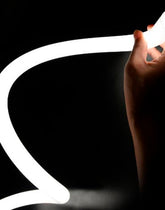FAQ
Welcome to the Ellumiglow FAQ page! Below, we've compiled answers to the most common questions we receive about electroluminescence, LEDs, lasers, and lighting. Whether you're a beginner or an expert, this guide will help you better understand the technology and its applications.
Electroluminescence (EL)
1. What is electroluminescence?
Electroluminescence (EL) is the process of creating light by applying an electric field to a phosphor-coated material. It does not generate heat, making it an efficient lighting source.
2. How does EL lighting compare to traditional lighting?
EL lighting is thinner, more flexible, and emits a uniform glow without hotspots. It is ideal for applications where space, efficiency, and even lighting distribution are key factors.
3. What are the different types of EL products?
EL lighting comes in various forms, including EL Wire, EL Tape, EL Panels, EL Paint, and VynEL®. Each type has unique applications and benefits.
4. How long do EL panels last?
Most EL panels last between 4,000 to 6,000 hours, depending on factors like voltage, frequency, and environmental conditions.
5. What power source is needed for EL products?
EL products require an inverter to convert low-voltage DC power to AC, which excites the phosphor material to emit light.
6. Can EL lighting be dimmed?
Yes, EL lighting can be dimmed by adjusting the frequency or voltage applied to the material.
7. Is EL lighting waterproof?
EL products are not inherently waterproof, but they can be sealed with protective coatings to enhance durability in outdoor or wet conditions.
8. What are the advantages of using EL wire over neon?
EL wire is flexible, energy-efficient, and can be powered by low-voltage sources, making it a safer alternative to traditional neon lighting.
LED Lighting
9. What is LED lighting?
LED (Light Emitting Diode) lighting is a semiconductor-based lighting technology that emits light when an electric current passes through it.
10. How do LEDs compare to EL lighting?
LEDs are directional and bright, whereas EL lighting emits an even, low-level glow. LEDs are better for spotlighting, while EL is ideal for accent lighting.
11. Do LEDs produce heat?
Yes, LEDs generate some heat, but significantly less than traditional incandescent bulbs.
12. What is the lifespan of an LED?
Most LEDs last between 25,000 to 50,000 hours, depending on usage and quality.
13. Are LEDs dimmable?
Yes, but not all LED bulbs are dimmable. Ensure you use a compatible dimmer switch for the best results.
14. What are smart LEDs?
Smart LEDs can be controlled remotely via Wi-Fi or Bluetooth, allowing users to adjust brightness, color, and timing schedules.
15. Can LEDs be used outdoors?
Yes, many LED products are designed for outdoor use. Look for an IP rating to determine their water and dust resistance.
Laser Lighting
16. What are laser lights?
Laser lights use coherent light beams to create highly focused, high-intensity illumination.
17. How do lasers compare to LEDs?
Lasers produce a narrow, intense beam of light, while LEDs emit a broader, more diffused light.
18. Are laser lights safe?
Laser lights should be used with caution. Direct exposure to eyes can cause damage, so always follow safety guidelines.
19. What are the common applications for laser lighting?
Laser lighting is used in entertainment, projection mapping, medical applications, and industrial cutting and engraving.
20. Can laser lights be used for home decor?
Yes, many laser projectors are designed for decorative purposes, such as holiday lighting or home theater ambiance.
General Lighting Questions
21. What is color temperature in lighting?
Color temperature, measured in Kelvin (K), determines the warmth or coolness of light. Lower values (2700K) appear warm, while higher values (6000K) appear cool.
22. What is CRI (Color Rendering Index)?
CRI measures how accurately a light source renders colors compared to natural sunlight. Higher CRI values (90+) indicate better color accuracy.
23. What is the difference between lumens and watts?
Lumens measure brightness, while watts measure energy consumption. More lumens mean brighter light, while lower watts mean greater efficiency.
24. Can different types of lighting be combined?
Yes! Many applications use a mix of EL, LED, and laser lighting to achieve the desired effect.
25. What is RGB lighting?
RGB lighting combines red, green, and blue LEDs to create millions of colors through blending and dimming control.
B2B Guide: Choosing The Right Lighting Technology For Your Next Project
This in-depth article explains the differences between the technologies, and best application uses for each technology. This is not an inclusive guide to every possible use, but a broad overview of where and when to use each technology.
- Choosing a selection results in a full page refresh.




